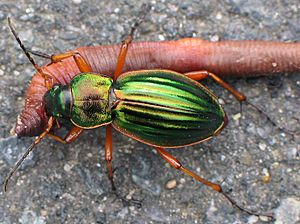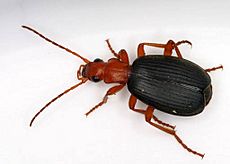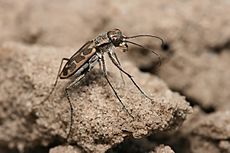Ground beetle facts for kids
Quick facts for kids Ground beetles |
|
|---|---|
 |
|
| Golden ground beetle eating an earthworm | |
| Scientific classification | |
| Kingdom: | |
| Phylum: | |
| Class: | |
| Order: | |
| Suborder: | |
| (unranked): | |
| Superfamily: |
Caraboidea
|
| Family: |
Carabidae
Latreille, 1802
|
Ground beetles are a huge group of beetles called the Carabidae. You can find them almost everywhere in the world. There are over 40,000 different kinds, or species, of ground beetles! About 2,000 species live in North America. Another 2,700 species are found in Europe. This family of beetles has many smaller groups within it.
Contents
What Do Ground Beetles Look Like?
Ground beetles come in many shapes and colors. Most of them are shiny black. Some have a cool metallic look. They often have bumpy or ridged wing covers. These covers are called elytra. In some large species that cannot fly, their wing covers are joined together.
Almost all ground beetles have a special groove on their front legs. This groove has a comb-like row of hairs. They use this comb to clean their antennae.
Where Do Ground Beetles Live?
Ground beetles like to live in hidden places. You can often find them under the bark of trees. They also hide under logs or among rocks. Some prefer sandy areas near ponds and rivers.
How Ground Beetles Live and Hunt
Most ground beetles are carnivores. This means they eat other animals. They actively hunt for any small invertebrates they can catch. Some species run very fast to catch their food. Tiger beetles are known for being super speedy runners.
Most ground beetles are nocturnal. This means they are active at night. But tiger beetles are different. They hunt during the day and often have bright colors. They have big eyes to help them see their prey.
One special type of ground beetle, Promecognathus laevissimus, eats only one kind of millipede. This millipede, Harpaphe haydeniana, is poisonous to most animals. But these beetles can handle the poison!
Amazing Beetle Defenses
Ground beetles have a cool way to protect themselves. They release bad-smelling liquids. This is common for the ancient beetle group they belong to, called Adephaga. They have special glands in their lower back part. These glands make liquids that can be stinky or even burning. They use these liquids to scare away animals that want to eat them.
Bombardier Beetles: A Popping Defense
Bombardier beetles have an even more amazing defense. They mix their liquids with other chemicals. When they spray it, it makes a loud popping sound! A cloud of hot, bad-smelling gas comes out. This can hurt small mammals like shrews. It can even kill small invertebrates. If a human gets "bombed" by one, it feels very unpleasant.
This special ability actually developed twice in different ground beetle groups. It's found in the very old flanged bombardier beetles. It's also in the more "modern" typical bombardier beetles.
Some ground beetles, like the Anthiini, can squirt their defense liquids far away. They can even aim very well!
Ground Beetles and Humans
Most ground beetles are helpful to humans. They eat many pests that harm crops. For example, caterpillar hunters are famous for eating lots of caterpillars. They love to eat caterpillars that most other animals avoid. These include tussock moth caterpillars and "woolly worms." These caterpillars have hairs that can irritate skin.
Long ago, in 1905, many forest caterpillar hunters were sent to New England. They helped control the gypsy moth there. This is a type of biological control. It means using one living thing to control another pest.
When Ground Beetles Can Be a Nuisance
A few ground beetle species can sometimes be a problem. The Zabrus genus is one of the few plant-eating ground beetles. Sometimes, Zabrus tenebrioides can become so numerous that it damages grain crops.
Large ground beetles can also be annoying if there are many of them. This is especially true during outdoor activities like camping. They release their stinky defense liquids when they feel threatened. If they hide near your food, they might spoil it.
Ground beetles usually don't fly, or they fly very little. So, it's often easy to block their way into your home or tent. Using bug sprays just for ground beetles is usually not a good idea. It might make them release their stinky liquids. It's better to use sprays only if you also want to get rid of ants or other crawling pests.
Images for kids
-
A crucifix ground beetle (Panagaeus cruxmajor) got Charles Darwin into trouble in 1828.
See also
 In Spanish: Carábidos para niños
In Spanish: Carábidos para niños










